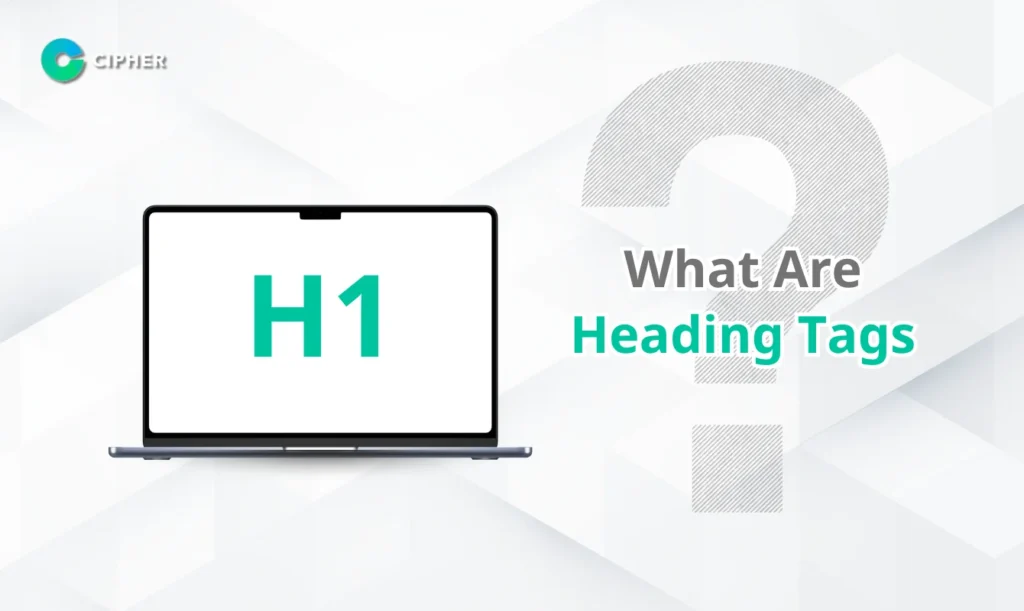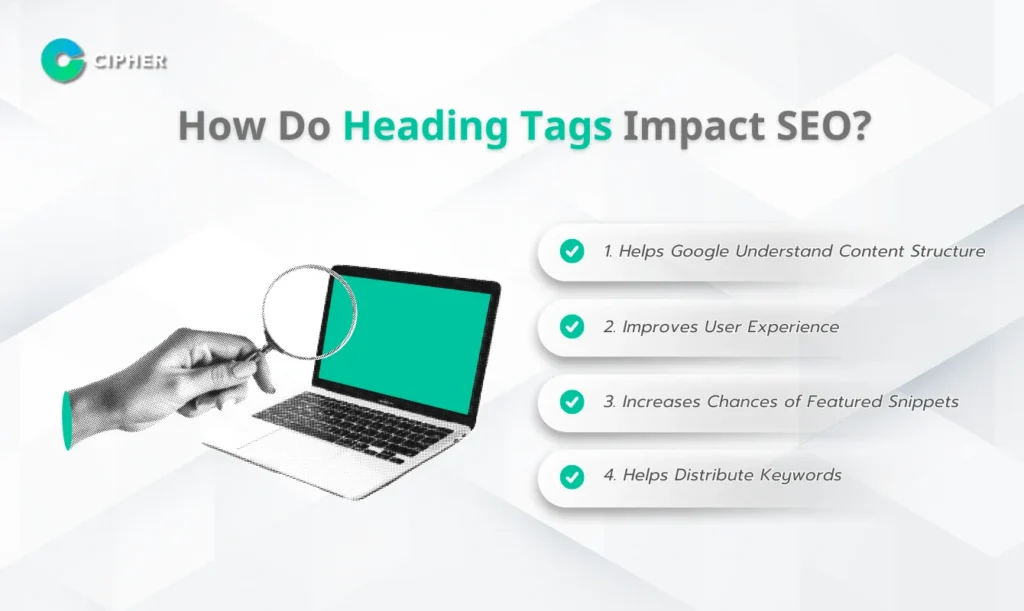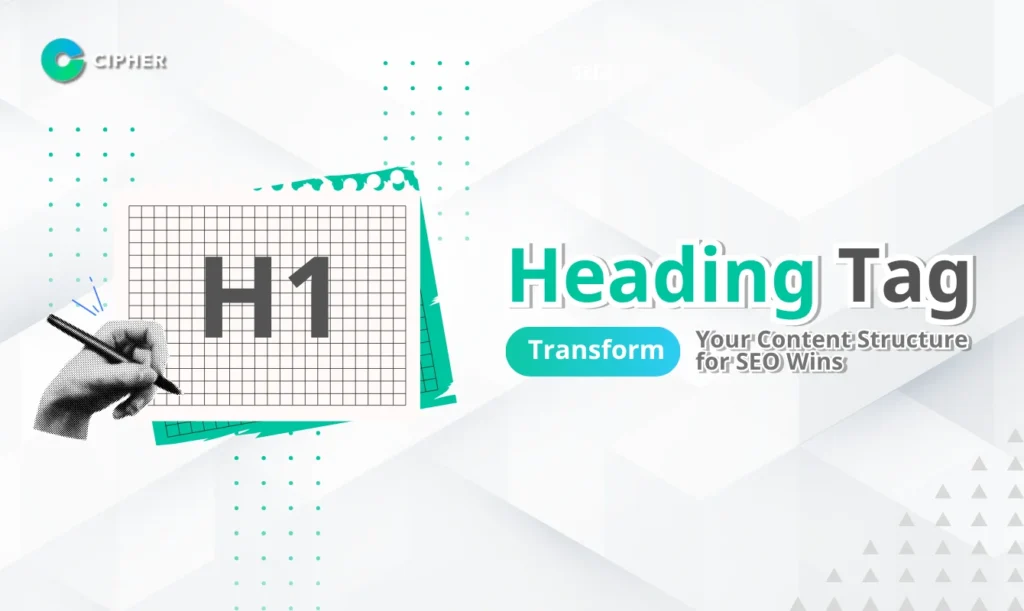If you’re running a website but still not ranking well in search results, or ranking but in poor positions, it’s time to check your Heading Tags! Many people overlook the importance of structuring Heading SEO on their websites. In reality, this is one of the key techniques that will help Google better understand your content and help push your website to rank faster.
Table of Contents
What Are Heading Tags?

Heading Tags are HTML tags used to define various headings on a website, divided into main headings and subheadings, ranging from H1 to H6. Using Header Tags for SEO helps organize content in a structured way, making it easier for both Google Bot and readers to understand the content structure.
Think of Heading Tags as a table of contents in a book that helps systematically divide headings and content, allowing readers to find information quickly – and this is something Google loves!
What Types of Heading Tags Are There?
1. Heading 1 (H1) - The Most Important Main Heading
H1 is like the title of your webpage, telling Google and readers what the entire page is about.
- You should have only 1 H1 per webpage
- Your main keyword should be included in the H1
- H1 is typically at the top of your content (not necessarily the top of the webpage)
Example of a good H1:
<h1>What Are Heading Tags? Techniques for Organizing Headers to Improve SEO Ranking</h1 >
2. Heading 2 (H2) - Secondary to H1
- You can have multiple H2s on one webpage
- Think of them as chapters or main topics in a book
- Should include main or secondary keywords
3. Heading 3-6 (H3-H6) - Further Subheadings
- H3 is a subheading under H2
- H4 is a subheading under H3
- H5 is a subheading under H4
- H6 is a subheading under H5
How Do Heading Tags Impact SEO?

1. Helps Google Understand Content Structure
When Google Bot examines your website, it reads the HTML code to understand the content. Proper Heading SEO helps Google recognize which parts of the content are important and how they relate to each other, allowing it to rank your website more accurately based on search queries.
2. Improves User Experience
Heading Tags are not only important for Google but also affect user experience. Clear headings help readers quickly scan for the information they need without reading everything.
Proper use of Heading SEO shows users that your website organizes information well. They’ll spend more time on your site, are more likely to click on other pages, and tend to return for more—all positive signals that Google considers when ranking.
3. Increases Chances of Featured Snippets
Google often pulls information from Heading Tags to display as Rich Snippets or Featured Snippets in search results (Zero Position), especially for content that directly answers questions.
For example, if you have an H2 saying “How to Clean a Washing Machine” followed by clear, step-by-step instructions, Google might pull this information to show as a Featured Snippet when someone searches for “how to clean washing machine,” increasing visibility and credibility for your website.
4. Helps Distribute Keywords
Techniques for Maximizing SEO Benefits with Heading Tags
1. Use H1 Only Once Per Page
H1 should appear only once on each page and should reflect the main content of that page. Using H1 multiple times might confuse Google about the main topic of the page.
Your H1 should:
- Clearly indicate the page’s content
- Be of appropriate length (about 50-70 characters)
- Include the main keyword you want to rank for
- Be written to benefit readers, not just for SEO
2. Arrange Heading Tags in the Correct Order
The order of Header Tags should be like a book’s table of contents, avoiding skipping levels, such as going from H2 to H4 without an H3 in between, which creates a disorganized content structure that can confuse both readers and Google.
The correct order for Heading SEO structure is:
- H1: Main title of the page
- H2: Major headings that divide content into sections
- H3: Subheadings under H2
- H4: Subheadings under H3
- H5-H6: Further subheadings
3. Distribute Keywords Naturally in Heading Tags
Including keywords in Header Tags for SEO is important but must be done naturally, not excessively. Recommendations:
- Include main keywords in H1 and H2
- Use secondary keywords or related terms in H3-H6
- Write for easy comprehension, not forced keyword inclusion
- Avoid repeating the same keywords in every Heading
Additionally, SEO a Tag optimization is also important. Using link text that matches Heading Tags will further enhance SEO effectiveness. The anchor text in your internal links should complement your heading structure for maximum SEO benefit.
4. Optimize for Featured Snippets
Optimize Heading Tags to be suitable for Featured Snippets with these methods:
- Use H2 or H3 formatted as questions, such as “What Are Heading Tags?”
- Follow question Headings with concise, clear answers
- Format information as lists or steps if appropriate
- Use tables, ordered lists, or unordered lists to organize information
5. Design Headings to Be Interesting and Readable
Beyond SEO benefits, Headings also help attract readers’ attention:
- Use easy-to-understand, clear language
- Keep length appropriate, neither too short nor too long
- Communicate the point directly
- Use attention-grabbing words like “Best Methods,” “Secret Techniques,” “That Nobody Tells You About”
Tools to Check Header Tags
Checking Heading Tags is important to ensure your website has a good structure. Several tools can help with this:
- View Page Source – Open the webpage, right-click, select “View Page Source” or press Ctrl+U to see the HTML code showing all Heading Tags
- Chrome DevTools – Press F12 or right-click on the webpage and select “Inspect” to open DevTools, then look at the Elements section
- SEO Tools – Specialized tools for SEO checking with features to analyze Heading Tags, such as:
- Screaming Frog – Scans websites and reports on Heading structure
- SEMrush – Has a Site Audit tool that checks for Heading-related issues
- Ahrefs – Provides information about Heading Structure in the Site Audit section
- Browser Extensions – Browser add-ons that make checking Heading Tags easy:
- SEOquake – Shows Heading Tag information and other SEO data
- HeadingsMap – Displays Heading structure in a map format
- SEO META in 1 CLICK – Shows SEO information including Heading Tags
Heading Tag Management Services from CIPHER
Our services related to Heading SEO include:
1. Analyzing and Optimizing Heading Tag Structure
2. Planning Keyword Strategy for Heading Tags
Our team will analyze appropriate keywords and plan their effective use in Heading Tags to increase your chances of ranking on Google.
3. Designing Heading Tags That Appeal to Users
4. Optimizing Heading Tags for Featured Snippets
5. Continuous Monitoring and Development
Summary
Heading Tags are an essential SEO element that many people overlook. Implementing proper Header Tags for SEO helps Google better understand content, allows readers to find information quickly, and increases chances of appearing in Featured Snippets.
If you want to improve your website rankings, focusing on Heading Tags and Heading SEO is a good starting point. Try using the techniques in this article, or contact CIPHER for comprehensive SEO consultation.





